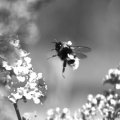The University of Queensland's Centre for Laser Science in the Physics Department has entered a new era for controlling single atoms with laser light beams.
This month the Centre installed a new titanium sapphire laser (Ti-Saph for short) which enables more powerful laser beams, with variable colors, to be used. The University funded the new equipment with a $350,000 research infrastructure grant.
Research programs using the new laser will be directed by research associate Andrew Truscott, who recently worked for 12 months in the laboratory of 1997 Nobel Laureate for Physics, Steve Chu of Stanford University.
Centre for Laser Science director and Physics Department head Professor Gerard Milburn said the new equipment would be applied to controlling the motion of individual atoms of rubidium that had been cooled to billionths of a degree above absolute zero by a system of magnetic and laser forces.
'Cold atoms are slow atoms,' he said. 'Temperature is a measure of how fast on average an individual atom is moving. An atom of rubidium at room temperature is moving very fast, about 100 metres per second.
'In a laser cooling scheme, atoms are slowed down to only a few centimetres per second. That is equivalent to taking a supersonic jet and slowing it to the speed of an ant. And it takes place in thousandths of a second.
'If an atom is slow enough it can be manipulated by the very weak forces that light itself can exert on matter. This means the atoms are isolated from all matter, floating in a vacuum, and so will not heat up. This has opened up an entire new field of physics known as atom optics.'
Professor Milburn said the field of atom optics was very new, barely 10 years old, but its importance was recognised this month with the award of the Nobel prize in physics to three pioneers of the field. Steve Chu of Stanford and Bill Phillips of the U.S. National Institute of Standards and Technology, Maryland were the two experimentalists who pioneered the methods used in the Centre for Laser Science for laser cooling, while Claude Cohen-Tannoudjhi was a theoretician working in Paris who explained how laser cooling actually works.
He said laser cooling opened up new areas for investigating the fundamental physical principles by which the world worked, and had many applications in place, or on the way.
'Steve Chu, for example, is developing new time standards using very slow atoms, as well as a new method for detecting local variations in gravity for application to the mining exploration industry,' Professor Milburn said.
Professor Milburn said the University of Queensland's Centre for Laser Science was a state-of-the-art atom optics laboratory.
'With the acquisition of the new Ti-Saph laser system, the Centre's experimentalists will now begin pushing the boundaries between the world of Newton and the quantum world.
'Andrew Truscott is directing this work. He has transferred the atom-trapping technology to University of Queensland research programs and brings considerable expertise to our effort in atomic optics.
'The quantum world works on an entirely new principle, but once we understand how to control nature at this level an entire technology, a quantum technology, will be available.'
For further information, contact Professor Milburn, telephone 07 3365 3405.



